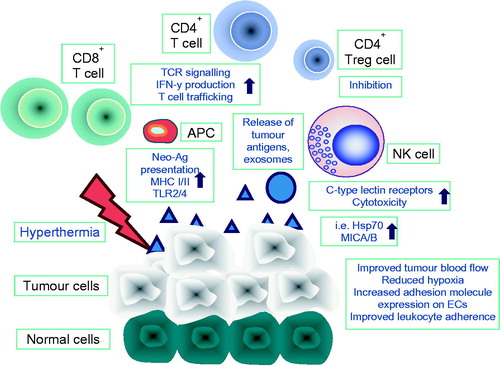Figures & data
Figure 1. Schematic representation of beneficial anti-tumour effects induced by hyperthermia on the immune system and tumour microenvironment. Local tumour hyperthermia can increase tumour perfusion and thus reduce tumour hypoxia. Hyperthermia can induce the expression of adhesion molecules like selectins and ICAM-1 on tumour endothelial cells (ECs) which may facilitate leucocyte adherence. Hyperthermia can induce the expression of stress-induced ligands such as Hsp70 and MICA/B which are recognised by C-type lectin receptors on NK cells and CD8+ cytotoxic T cells, and thus can increase their cytolytic activity. High temperatures have also been shown to kill T regs which are known to repress immune responses. CD4+ as well as CD8+ T cells are attracted by an up-regulated expression of adhesion molecules on tumour blood vessels following exposure to heat. Hyperthermia can activate antigen presenting cells (APCs) and thus increase their expression of MHC class I/II molecules, CD40, CD86, CD80, and Toll-like receptors. The elevated expression and release of heat-induced tumour neo-antigens, either as free molecules or as exosomes which are cross-presented by APCs following uptake, induce an increased T cell signalling and an increased secretion of IFN-y by cytotoxic CD8+ T cells.

